Report on Skills for Academic Study: Resources, Styles, and Techniques
VerifiedAdded on 2020/10/05
|18
|4450
|263
Report
AI Summary
This report comprehensively examines skills for academic study, detailing key resources available to facilitate learning and study, including textbooks, online applications, and study guides. It analyzes learning styles using the VARK model and provides insights into conducting literature searches using EBSCO. The report explores various note-taking techniques such as linear note-taking, mind mapping, and graphical organizers, evaluating their effectiveness. It investigates how lifestyle choices impact an individual's health, referencing journal articles, e-books, and websites. The report also addresses plagiarism, providing a fact sheet on how to avoid it, and concludes by producing a timetable for study and a critical reflection on the module's learning outcomes. The findings emphasize the importance of motivation, self-evaluation, and adopting healthy lifestyle choices to enhance academic performance.
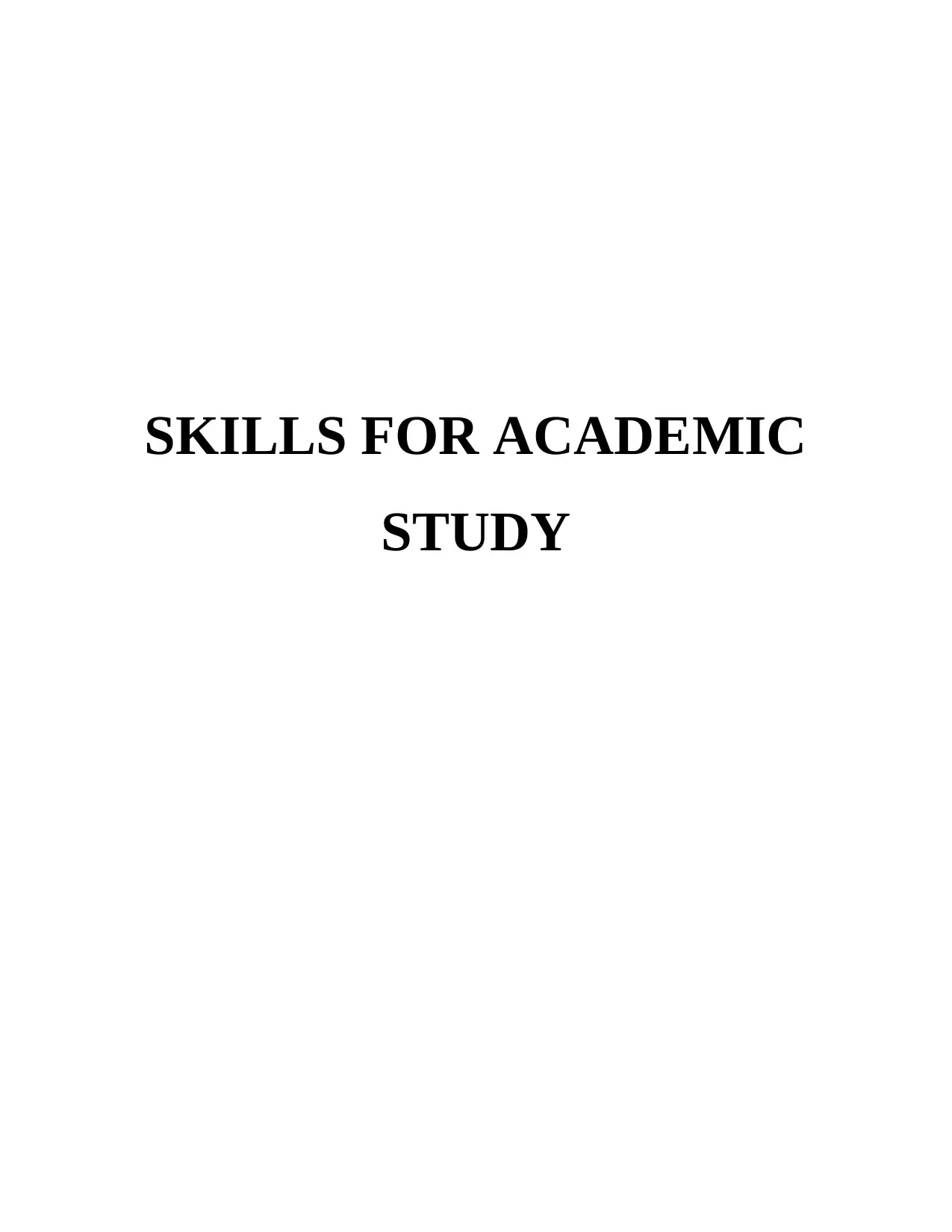
SKILLS FOR ACADEMIC
STUDY
STUDY
Paraphrase This Document
Need a fresh take? Get an instant paraphrase of this document with our AI Paraphraser
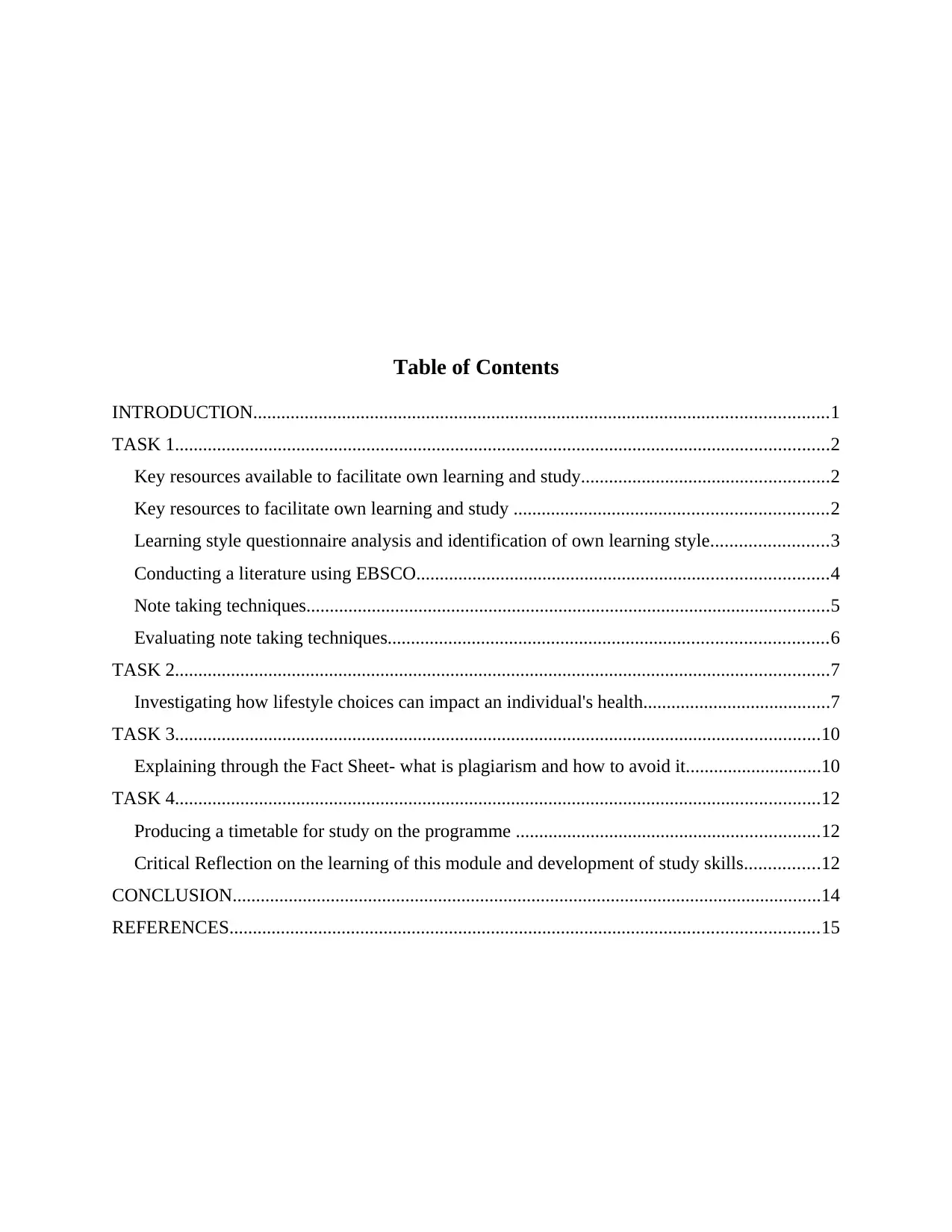
Table of Contents
INTRODUCTION...........................................................................................................................1
TASK 1............................................................................................................................................2
Key resources available to facilitate own learning and study.....................................................2
Key resources to facilitate own learning and study ...................................................................2
Learning style questionnaire analysis and identification of own learning style.........................3
Conducting a literature using EBSCO........................................................................................4
Note taking techniques................................................................................................................5
Evaluating note taking techniques..............................................................................................6
TASK 2............................................................................................................................................7
Investigating how lifestyle choices can impact an individual's health........................................7
TASK 3..........................................................................................................................................10
Explaining through the Fact Sheet- what is plagiarism and how to avoid it.............................10
TASK 4..........................................................................................................................................12
Producing a timetable for study on the programme .................................................................12
Critical Reflection on the learning of this module and development of study skills................12
CONCLUSION..............................................................................................................................14
REFERENCES..............................................................................................................................15
INTRODUCTION...........................................................................................................................1
TASK 1............................................................................................................................................2
Key resources available to facilitate own learning and study.....................................................2
Key resources to facilitate own learning and study ...................................................................2
Learning style questionnaire analysis and identification of own learning style.........................3
Conducting a literature using EBSCO........................................................................................4
Note taking techniques................................................................................................................5
Evaluating note taking techniques..............................................................................................6
TASK 2............................................................................................................................................7
Investigating how lifestyle choices can impact an individual's health........................................7
TASK 3..........................................................................................................................................10
Explaining through the Fact Sheet- what is plagiarism and how to avoid it.............................10
TASK 4..........................................................................................................................................12
Producing a timetable for study on the programme .................................................................12
Critical Reflection on the learning of this module and development of study skills................12
CONCLUSION..............................................................................................................................14
REFERENCES..............................................................................................................................15
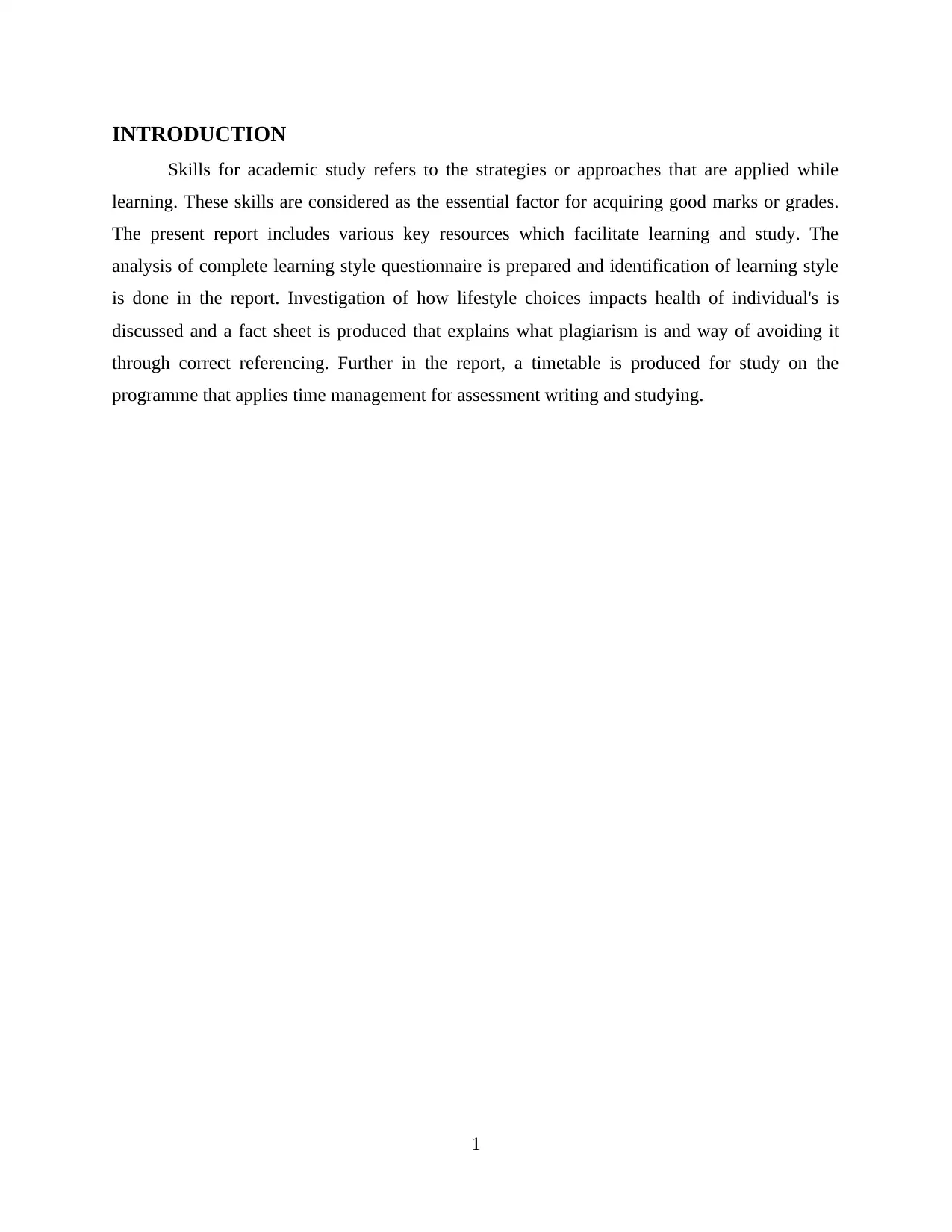
INTRODUCTION
Skills for academic study refers to the strategies or approaches that are applied while
learning. These skills are considered as the essential factor for acquiring good marks or grades.
The present report includes various key resources which facilitate learning and study. The
analysis of complete learning style questionnaire is prepared and identification of learning style
is done in the report. Investigation of how lifestyle choices impacts health of individual's is
discussed and a fact sheet is produced that explains what plagiarism is and way of avoiding it
through correct referencing. Further in the report, a timetable is produced for study on the
programme that applies time management for assessment writing and studying.
1
Skills for academic study refers to the strategies or approaches that are applied while
learning. These skills are considered as the essential factor for acquiring good marks or grades.
The present report includes various key resources which facilitate learning and study. The
analysis of complete learning style questionnaire is prepared and identification of learning style
is done in the report. Investigation of how lifestyle choices impacts health of individual's is
discussed and a fact sheet is produced that explains what plagiarism is and way of avoiding it
through correct referencing. Further in the report, a timetable is produced for study on the
programme that applies time management for assessment writing and studying.
1
⊘ This is a preview!⊘
Do you want full access?
Subscribe today to unlock all pages.

Trusted by 1+ million students worldwide
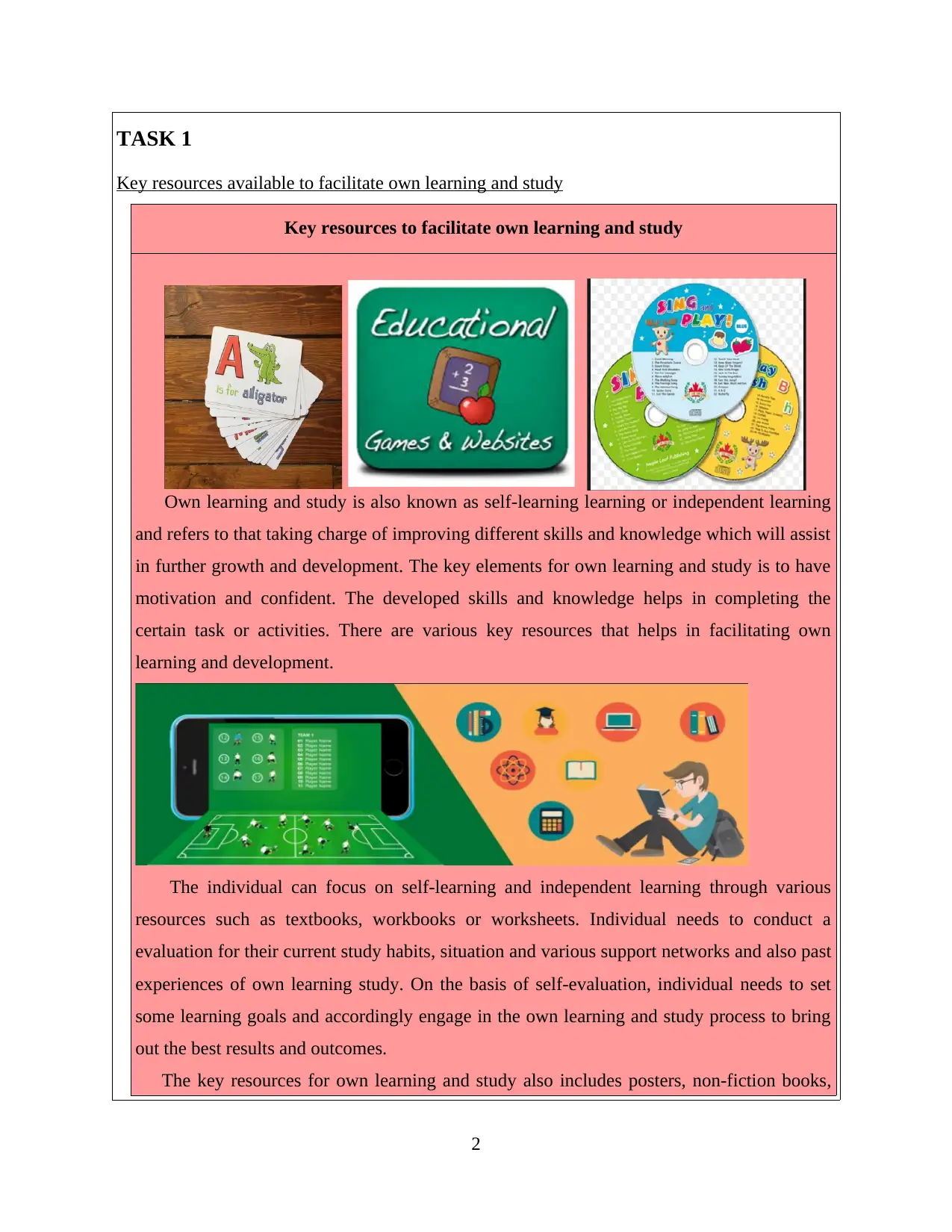
TASK 1
Key resources available to facilitate own learning and study
Key resources to facilitate own learning and study
Own learning and study is also known as self-learning learning or independent learning
and refers to that taking charge of improving different skills and knowledge which will assist
in further growth and development. The key elements for own learning and study is to have
motivation and confident. The developed skills and knowledge helps in completing the
certain task or activities. There are various key resources that helps in facilitating own
learning and development.
The individual can focus on self-learning and independent learning through various
resources such as textbooks, workbooks or worksheets. Individual needs to conduct a
evaluation for their current study habits, situation and various support networks and also past
experiences of own learning study. On the basis of self-evaluation, individual needs to set
some learning goals and accordingly engage in the own learning and study process to bring
out the best results and outcomes.
The key resources for own learning and study also includes posters, non-fiction books,
2
Key resources available to facilitate own learning and study
Key resources to facilitate own learning and study
Own learning and study is also known as self-learning learning or independent learning
and refers to that taking charge of improving different skills and knowledge which will assist
in further growth and development. The key elements for own learning and study is to have
motivation and confident. The developed skills and knowledge helps in completing the
certain task or activities. There are various key resources that helps in facilitating own
learning and development.
The individual can focus on self-learning and independent learning through various
resources such as textbooks, workbooks or worksheets. Individual needs to conduct a
evaluation for their current study habits, situation and various support networks and also past
experiences of own learning study. On the basis of self-evaluation, individual needs to set
some learning goals and accordingly engage in the own learning and study process to bring
out the best results and outcomes.
The key resources for own learning and study also includes posters, non-fiction books,
2
Paraphrase This Document
Need a fresh take? Get an instant paraphrase of this document with our AI Paraphraser
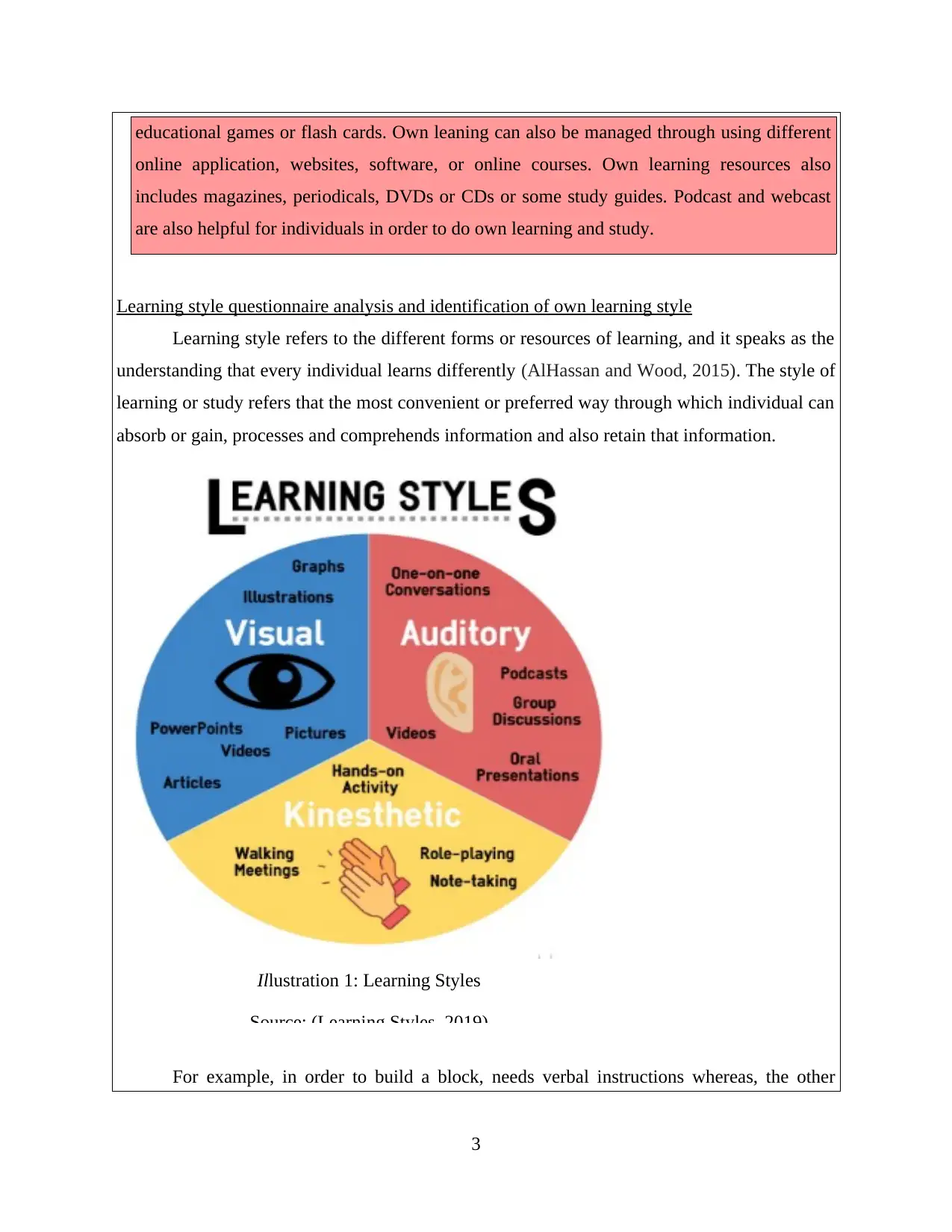
educational games or flash cards. Own leaning can also be managed through using different
online application, websites, software, or online courses. Own learning resources also
includes magazines, periodicals, DVDs or CDs or some study guides. Podcast and webcast
are also helpful for individuals in order to do own learning and study.
Learning style questionnaire analysis and identification of own learning style
Learning style refers to the different forms or resources of learning, and it speaks as the
understanding that every individual learns differently (AlHassan and Wood, 2015). The style of
learning or study refers that the most convenient or preferred way through which individual can
absorb or gain, processes and comprehends information and also retain that information.
Illustration 1: Learning Styles
Source: (Learning Styles, 2019)
For example, in order to build a block, needs verbal instructions whereas, the other
3
online application, websites, software, or online courses. Own learning resources also
includes magazines, periodicals, DVDs or CDs or some study guides. Podcast and webcast
are also helpful for individuals in order to do own learning and study.
Learning style questionnaire analysis and identification of own learning style
Learning style refers to the different forms or resources of learning, and it speaks as the
understanding that every individual learns differently (AlHassan and Wood, 2015). The style of
learning or study refers that the most convenient or preferred way through which individual can
absorb or gain, processes and comprehends information and also retain that information.
Illustration 1: Learning Styles
Source: (Learning Styles, 2019)
For example, in order to build a block, needs verbal instructions whereas, the other
3
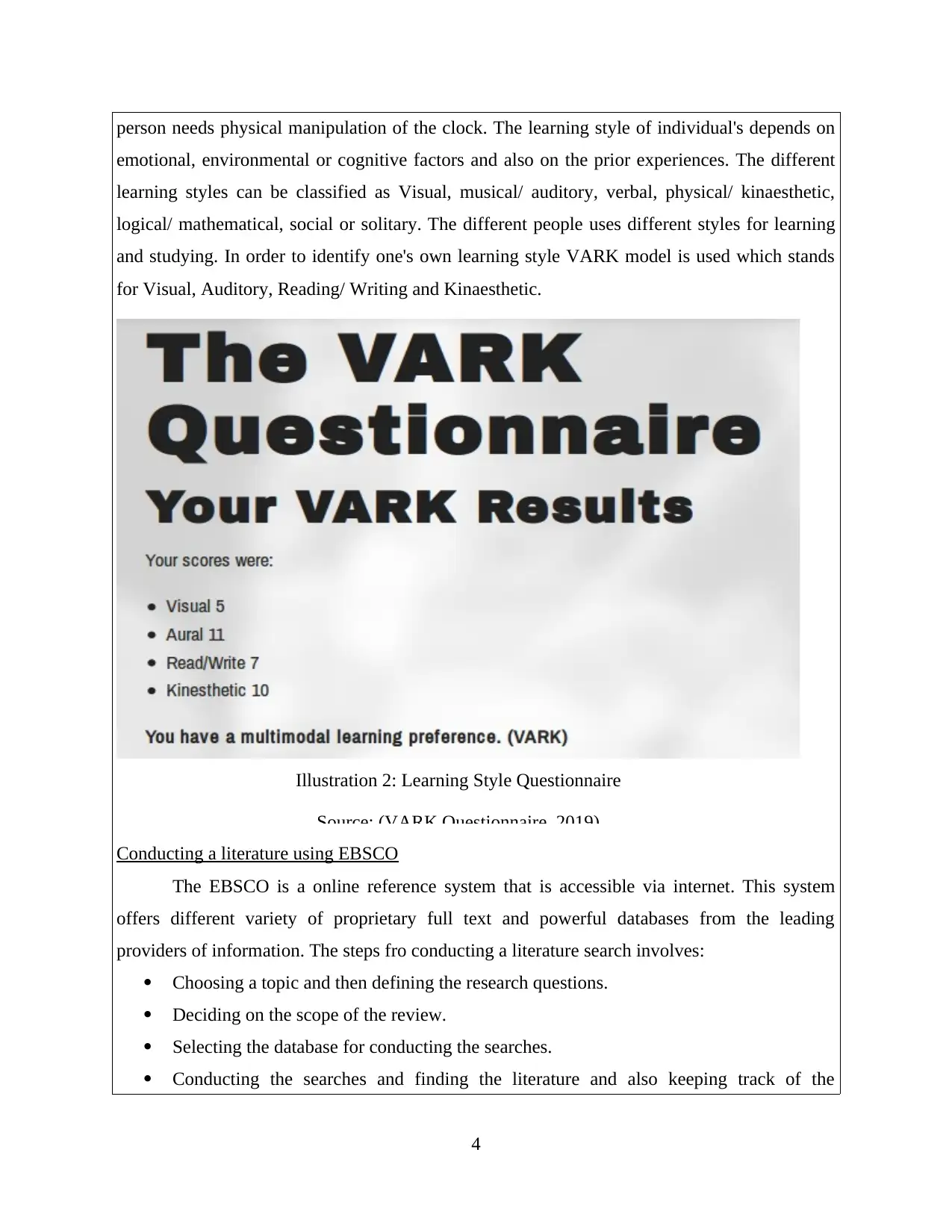
person needs physical manipulation of the clock. The learning style of individual's depends on
emotional, environmental or cognitive factors and also on the prior experiences. The different
learning styles can be classified as Visual, musical/ auditory, verbal, physical/ kinaesthetic,
logical/ mathematical, social or solitary. The different people uses different styles for learning
and studying. In order to identify one's own learning style VARK model is used which stands
for Visual, Auditory, Reading/ Writing and Kinaesthetic.
Illustration 2: Learning Style Questionnaire
Source: (VARK Questionnaire, 2019)
Conducting a literature using EBSCO
The EBSCO is a online reference system that is accessible via internet. This system
offers different variety of proprietary full text and powerful databases from the leading
providers of information. The steps fro conducting a literature search involves:
Choosing a topic and then defining the research questions.
Deciding on the scope of the review.
Selecting the database for conducting the searches.
Conducting the searches and finding the literature and also keeping track of the
4
emotional, environmental or cognitive factors and also on the prior experiences. The different
learning styles can be classified as Visual, musical/ auditory, verbal, physical/ kinaesthetic,
logical/ mathematical, social or solitary. The different people uses different styles for learning
and studying. In order to identify one's own learning style VARK model is used which stands
for Visual, Auditory, Reading/ Writing and Kinaesthetic.
Illustration 2: Learning Style Questionnaire
Source: (VARK Questionnaire, 2019)
Conducting a literature using EBSCO
The EBSCO is a online reference system that is accessible via internet. This system
offers different variety of proprietary full text and powerful databases from the leading
providers of information. The steps fro conducting a literature search involves:
Choosing a topic and then defining the research questions.
Deciding on the scope of the review.
Selecting the database for conducting the searches.
Conducting the searches and finding the literature and also keeping track of the
4
⊘ This is a preview!⊘
Do you want full access?
Subscribe today to unlock all pages.

Trusted by 1+ million students worldwide
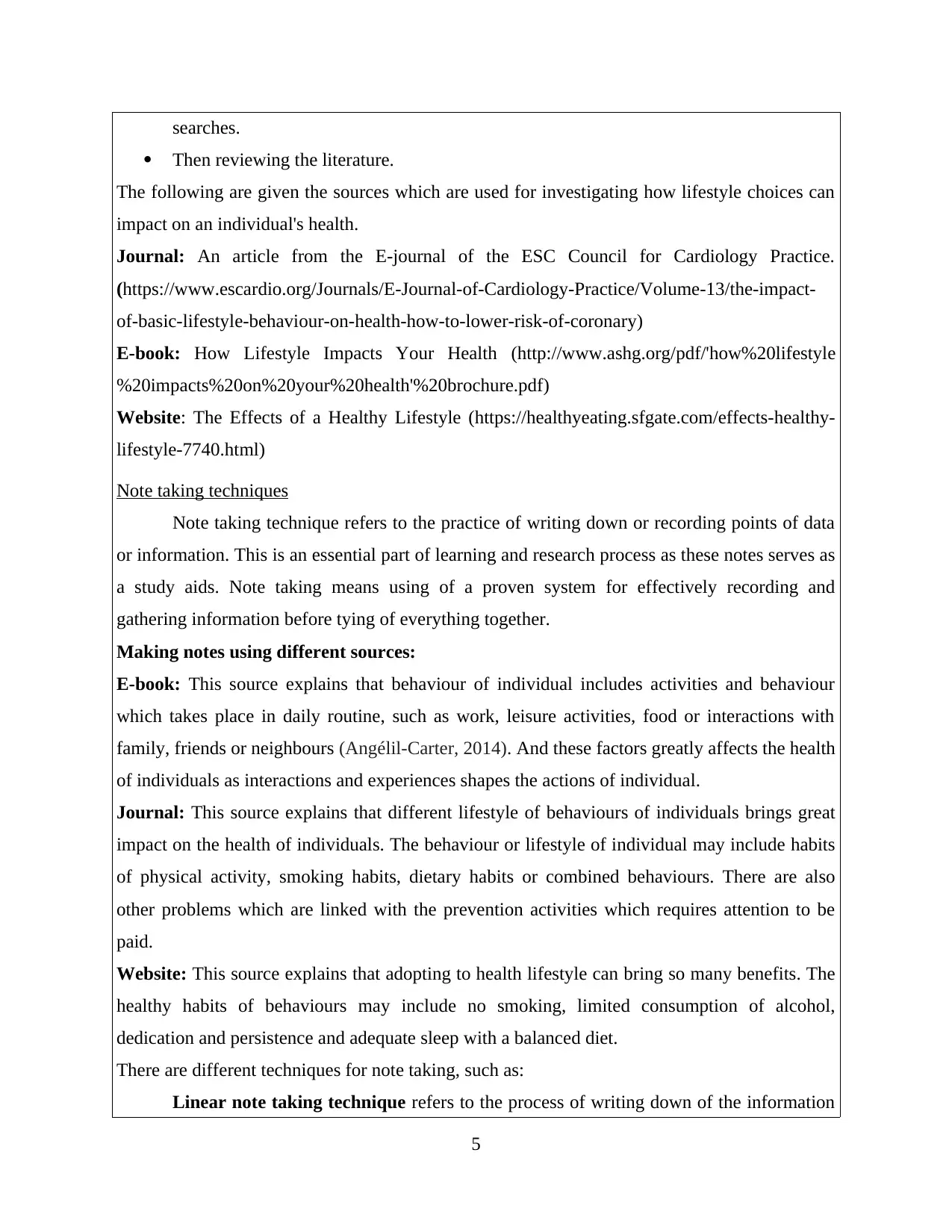
searches.
Then reviewing the literature.
The following are given the sources which are used for investigating how lifestyle choices can
impact on an individual's health.
Journal: An article from the E-journal of the ESC Council for Cardiology Practice.
(https://www.escardio.org/Journals/E-Journal-of-Cardiology-Practice/Volume-13/the-impact-
of-basic-lifestyle-behaviour-on-health-how-to-lower-risk-of-coronary)
E-book: How Lifestyle Impacts Your Health (http://www.ashg.org/pdf/'how%20lifestyle
%20impacts%20on%20your%20health'%20brochure.pdf)
Website: The Effects of a Healthy Lifestyle (https://healthyeating.sfgate.com/effects-healthy-
lifestyle-7740.html)
Note taking techniques
Note taking technique refers to the practice of writing down or recording points of data
or information. This is an essential part of learning and research process as these notes serves as
a study aids. Note taking means using of a proven system for effectively recording and
gathering information before tying of everything together.
Making notes using different sources:
E-book: This source explains that behaviour of individual includes activities and behaviour
which takes place in daily routine, such as work, leisure activities, food or interactions with
family, friends or neighbours (Angélil-Carter, 2014). And these factors greatly affects the health
of individuals as interactions and experiences shapes the actions of individual.
Journal: This source explains that different lifestyle of behaviours of individuals brings great
impact on the health of individuals. The behaviour or lifestyle of individual may include habits
of physical activity, smoking habits, dietary habits or combined behaviours. There are also
other problems which are linked with the prevention activities which requires attention to be
paid.
Website: This source explains that adopting to health lifestyle can bring so many benefits. The
healthy habits of behaviours may include no smoking, limited consumption of alcohol,
dedication and persistence and adequate sleep with a balanced diet.
There are different techniques for note taking, such as:
Linear note taking technique refers to the process of writing down of the information
5
Then reviewing the literature.
The following are given the sources which are used for investigating how lifestyle choices can
impact on an individual's health.
Journal: An article from the E-journal of the ESC Council for Cardiology Practice.
(https://www.escardio.org/Journals/E-Journal-of-Cardiology-Practice/Volume-13/the-impact-
of-basic-lifestyle-behaviour-on-health-how-to-lower-risk-of-coronary)
E-book: How Lifestyle Impacts Your Health (http://www.ashg.org/pdf/'how%20lifestyle
%20impacts%20on%20your%20health'%20brochure.pdf)
Website: The Effects of a Healthy Lifestyle (https://healthyeating.sfgate.com/effects-healthy-
lifestyle-7740.html)
Note taking techniques
Note taking technique refers to the practice of writing down or recording points of data
or information. This is an essential part of learning and research process as these notes serves as
a study aids. Note taking means using of a proven system for effectively recording and
gathering information before tying of everything together.
Making notes using different sources:
E-book: This source explains that behaviour of individual includes activities and behaviour
which takes place in daily routine, such as work, leisure activities, food or interactions with
family, friends or neighbours (Angélil-Carter, 2014). And these factors greatly affects the health
of individuals as interactions and experiences shapes the actions of individual.
Journal: This source explains that different lifestyle of behaviours of individuals brings great
impact on the health of individuals. The behaviour or lifestyle of individual may include habits
of physical activity, smoking habits, dietary habits or combined behaviours. There are also
other problems which are linked with the prevention activities which requires attention to be
paid.
Website: This source explains that adopting to health lifestyle can bring so many benefits. The
healthy habits of behaviours may include no smoking, limited consumption of alcohol,
dedication and persistence and adequate sleep with a balanced diet.
There are different techniques for note taking, such as:
Linear note taking technique refers to the process of writing down of the information
5
Paraphrase This Document
Need a fresh take? Get an instant paraphrase of this document with our AI Paraphraser
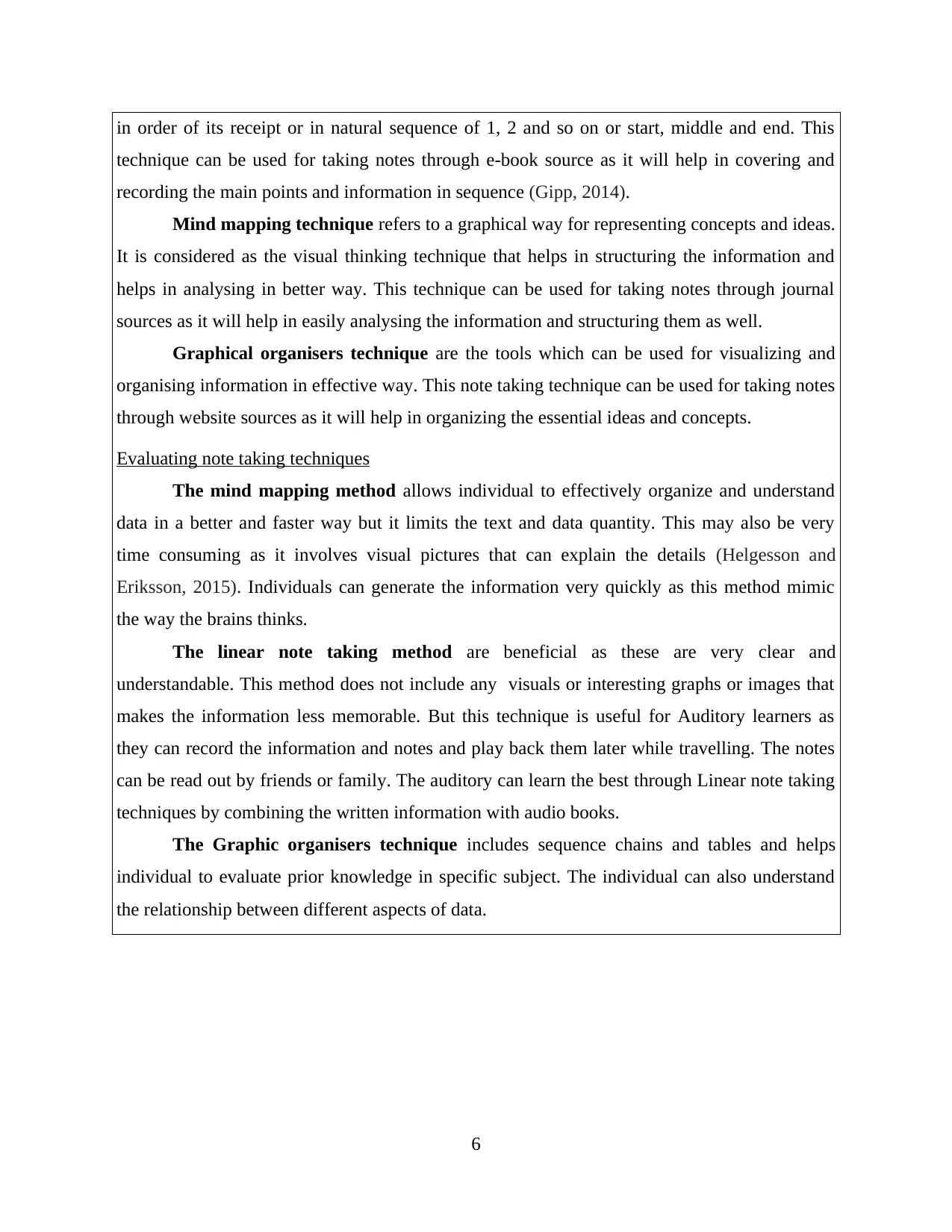
in order of its receipt or in natural sequence of 1, 2 and so on or start, middle and end. This
technique can be used for taking notes through e-book source as it will help in covering and
recording the main points and information in sequence (Gipp, 2014).
Mind mapping technique refers to a graphical way for representing concepts and ideas.
It is considered as the visual thinking technique that helps in structuring the information and
helps in analysing in better way. This technique can be used for taking notes through journal
sources as it will help in easily analysing the information and structuring them as well.
Graphical organisers technique are the tools which can be used for visualizing and
organising information in effective way. This note taking technique can be used for taking notes
through website sources as it will help in organizing the essential ideas and concepts.
Evaluating note taking techniques
The mind mapping method allows individual to effectively organize and understand
data in a better and faster way but it limits the text and data quantity. This may also be very
time consuming as it involves visual pictures that can explain the details (Helgesson and
Eriksson, 2015). Individuals can generate the information very quickly as this method mimic
the way the brains thinks.
The linear note taking method are beneficial as these are very clear and
understandable. This method does not include any visuals or interesting graphs or images that
makes the information less memorable. But this technique is useful for Auditory learners as
they can record the information and notes and play back them later while travelling. The notes
can be read out by friends or family. The auditory can learn the best through Linear note taking
techniques by combining the written information with audio books.
The Graphic organisers technique includes sequence chains and tables and helps
individual to evaluate prior knowledge in specific subject. The individual can also understand
the relationship between different aspects of data.
6
technique can be used for taking notes through e-book source as it will help in covering and
recording the main points and information in sequence (Gipp, 2014).
Mind mapping technique refers to a graphical way for representing concepts and ideas.
It is considered as the visual thinking technique that helps in structuring the information and
helps in analysing in better way. This technique can be used for taking notes through journal
sources as it will help in easily analysing the information and structuring them as well.
Graphical organisers technique are the tools which can be used for visualizing and
organising information in effective way. This note taking technique can be used for taking notes
through website sources as it will help in organizing the essential ideas and concepts.
Evaluating note taking techniques
The mind mapping method allows individual to effectively organize and understand
data in a better and faster way but it limits the text and data quantity. This may also be very
time consuming as it involves visual pictures that can explain the details (Helgesson and
Eriksson, 2015). Individuals can generate the information very quickly as this method mimic
the way the brains thinks.
The linear note taking method are beneficial as these are very clear and
understandable. This method does not include any visuals or interesting graphs or images that
makes the information less memorable. But this technique is useful for Auditory learners as
they can record the information and notes and play back them later while travelling. The notes
can be read out by friends or family. The auditory can learn the best through Linear note taking
techniques by combining the written information with audio books.
The Graphic organisers technique includes sequence chains and tables and helps
individual to evaluate prior knowledge in specific subject. The individual can also understand
the relationship between different aspects of data.
6
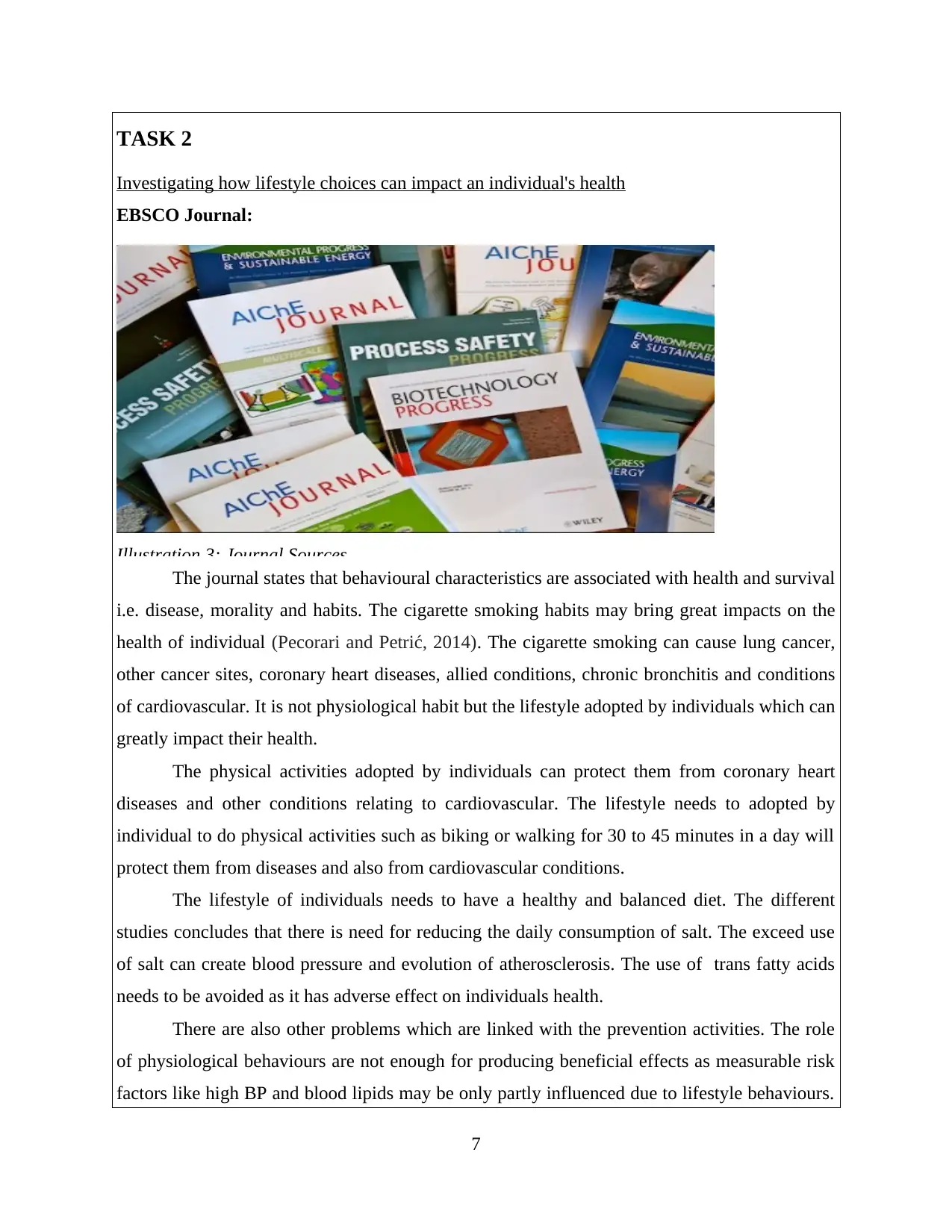
TASK 2
Investigating how lifestyle choices can impact an individual's health
EBSCO Journal:
Illustration 3: Journal Sources
The journal states that behavioural characteristics are associated with health and survival
i.e. disease, morality and habits. The cigarette smoking habits may bring great impacts on the
health of individual (Pecorari and Petrić, 2014). The cigarette smoking can cause lung cancer,
other cancer sites, coronary heart diseases, allied conditions, chronic bronchitis and conditions
of cardiovascular. It is not physiological habit but the lifestyle adopted by individuals which can
greatly impact their health.
The physical activities adopted by individuals can protect them from coronary heart
diseases and other conditions relating to cardiovascular. The lifestyle needs to adopted by
individual to do physical activities such as biking or walking for 30 to 45 minutes in a day will
protect them from diseases and also from cardiovascular conditions.
The lifestyle of individuals needs to have a healthy and balanced diet. The different
studies concludes that there is need for reducing the daily consumption of salt. The exceed use
of salt can create blood pressure and evolution of atherosclerosis. The use of trans fatty acids
needs to be avoided as it has adverse effect on individuals health.
There are also other problems which are linked with the prevention activities. The role
of physiological behaviours are not enough for producing beneficial effects as measurable risk
factors like high BP and blood lipids may be only partly influenced due to lifestyle behaviours.
7
Investigating how lifestyle choices can impact an individual's health
EBSCO Journal:
Illustration 3: Journal Sources
The journal states that behavioural characteristics are associated with health and survival
i.e. disease, morality and habits. The cigarette smoking habits may bring great impacts on the
health of individual (Pecorari and Petrić, 2014). The cigarette smoking can cause lung cancer,
other cancer sites, coronary heart diseases, allied conditions, chronic bronchitis and conditions
of cardiovascular. It is not physiological habit but the lifestyle adopted by individuals which can
greatly impact their health.
The physical activities adopted by individuals can protect them from coronary heart
diseases and other conditions relating to cardiovascular. The lifestyle needs to adopted by
individual to do physical activities such as biking or walking for 30 to 45 minutes in a day will
protect them from diseases and also from cardiovascular conditions.
The lifestyle of individuals needs to have a healthy and balanced diet. The different
studies concludes that there is need for reducing the daily consumption of salt. The exceed use
of salt can create blood pressure and evolution of atherosclerosis. The use of trans fatty acids
needs to be avoided as it has adverse effect on individuals health.
There are also other problems which are linked with the prevention activities. The role
of physiological behaviours are not enough for producing beneficial effects as measurable risk
factors like high BP and blood lipids may be only partly influenced due to lifestyle behaviours.
7
⊘ This is a preview!⊘
Do you want full access?
Subscribe today to unlock all pages.

Trusted by 1+ million students worldwide
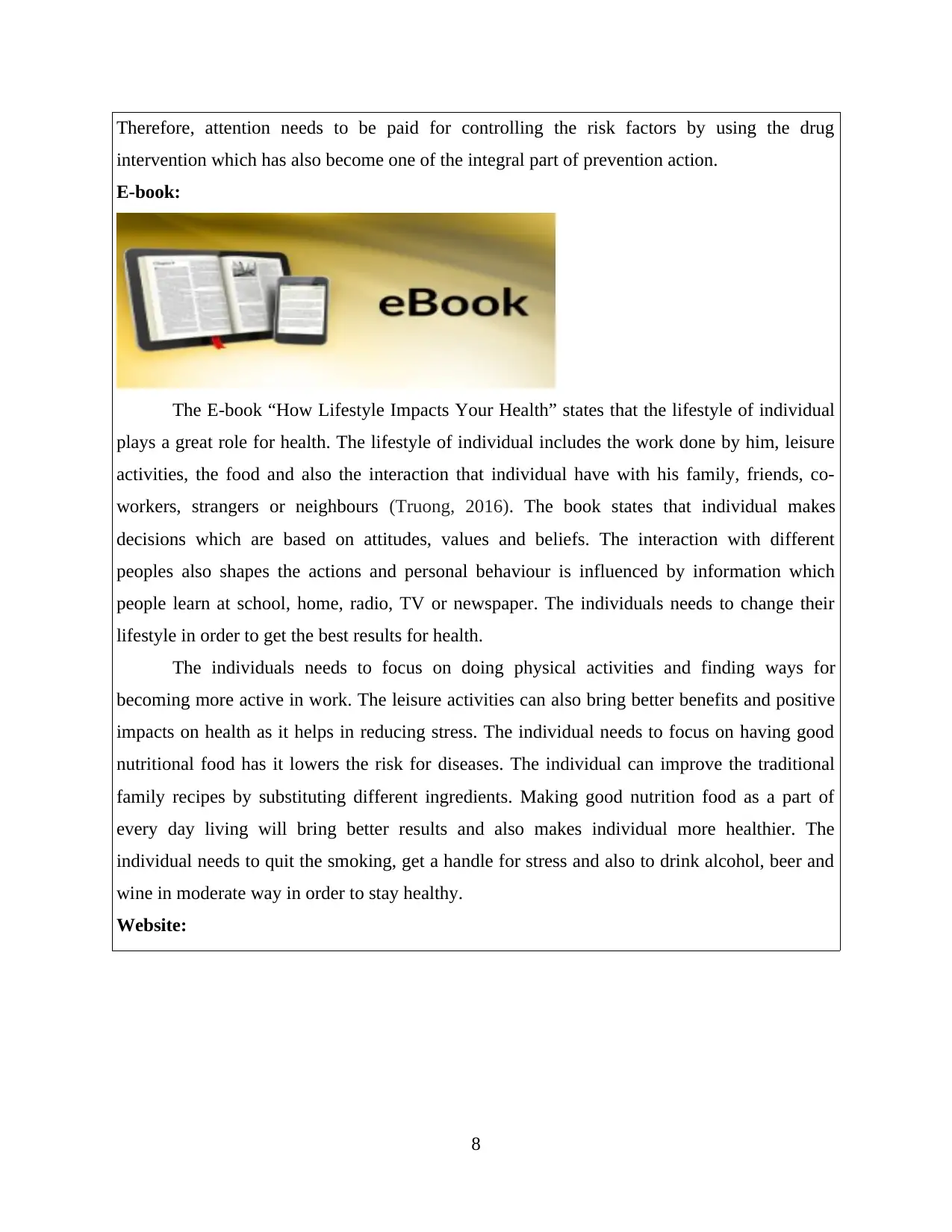
Therefore, attention needs to be paid for controlling the risk factors by using the drug
intervention which has also become one of the integral part of prevention action.
E-book:
The E-book “How Lifestyle Impacts Your Health” states that the lifestyle of individual
plays a great role for health. The lifestyle of individual includes the work done by him, leisure
activities, the food and also the interaction that individual have with his family, friends, co-
workers, strangers or neighbours (Truong, 2016). The book states that individual makes
decisions which are based on attitudes, values and beliefs. The interaction with different
peoples also shapes the actions and personal behaviour is influenced by information which
people learn at school, home, radio, TV or newspaper. The individuals needs to change their
lifestyle in order to get the best results for health.
The individuals needs to focus on doing physical activities and finding ways for
becoming more active in work. The leisure activities can also bring better benefits and positive
impacts on health as it helps in reducing stress. The individual needs to focus on having good
nutritional food has it lowers the risk for diseases. The individual can improve the traditional
family recipes by substituting different ingredients. Making good nutrition food as a part of
every day living will bring better results and also makes individual more healthier. The
individual needs to quit the smoking, get a handle for stress and also to drink alcohol, beer and
wine in moderate way in order to stay healthy.
Website:
8
intervention which has also become one of the integral part of prevention action.
E-book:
The E-book “How Lifestyle Impacts Your Health” states that the lifestyle of individual
plays a great role for health. The lifestyle of individual includes the work done by him, leisure
activities, the food and also the interaction that individual have with his family, friends, co-
workers, strangers or neighbours (Truong, 2016). The book states that individual makes
decisions which are based on attitudes, values and beliefs. The interaction with different
peoples also shapes the actions and personal behaviour is influenced by information which
people learn at school, home, radio, TV or newspaper. The individuals needs to change their
lifestyle in order to get the best results for health.
The individuals needs to focus on doing physical activities and finding ways for
becoming more active in work. The leisure activities can also bring better benefits and positive
impacts on health as it helps in reducing stress. The individual needs to focus on having good
nutritional food has it lowers the risk for diseases. The individual can improve the traditional
family recipes by substituting different ingredients. Making good nutrition food as a part of
every day living will bring better results and also makes individual more healthier. The
individual needs to quit the smoking, get a handle for stress and also to drink alcohol, beer and
wine in moderate way in order to stay healthy.
Website:
8
Paraphrase This Document
Need a fresh take? Get an instant paraphrase of this document with our AI Paraphraser
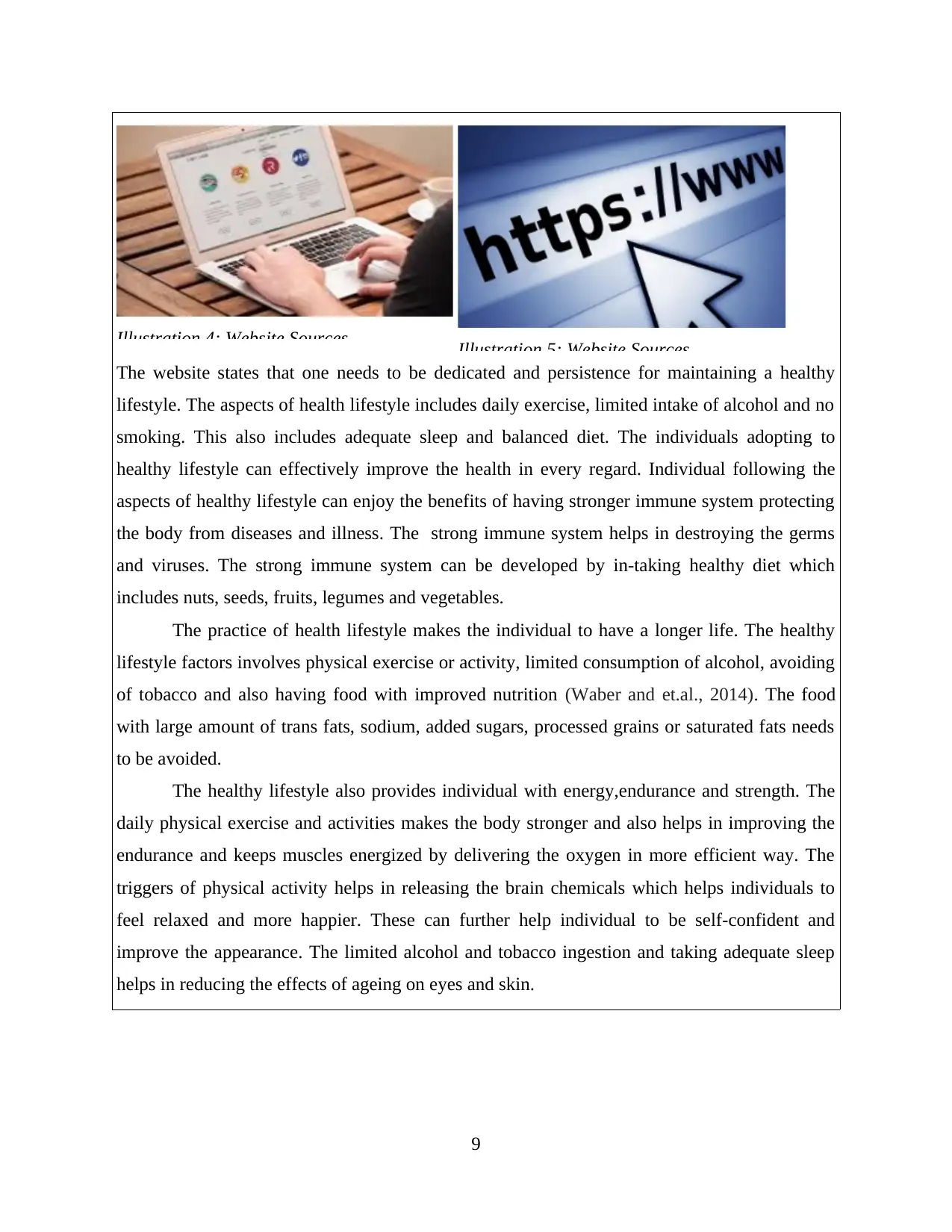
Illustration 4: Website Sources Illustration 5: Website Sources
The website states that one needs to be dedicated and persistence for maintaining a healthy
lifestyle. The aspects of health lifestyle includes daily exercise, limited intake of alcohol and no
smoking. This also includes adequate sleep and balanced diet. The individuals adopting to
healthy lifestyle can effectively improve the health in every regard. Individual following the
aspects of healthy lifestyle can enjoy the benefits of having stronger immune system protecting
the body from diseases and illness. The strong immune system helps in destroying the germs
and viruses. The strong immune system can be developed by in-taking healthy diet which
includes nuts, seeds, fruits, legumes and vegetables.
The practice of health lifestyle makes the individual to have a longer life. The healthy
lifestyle factors involves physical exercise or activity, limited consumption of alcohol, avoiding
of tobacco and also having food with improved nutrition (Waber and et.al., 2014). The food
with large amount of trans fats, sodium, added sugars, processed grains or saturated fats needs
to be avoided.
The healthy lifestyle also provides individual with energy,endurance and strength. The
daily physical exercise and activities makes the body stronger and also helps in improving the
endurance and keeps muscles energized by delivering the oxygen in more efficient way. The
triggers of physical activity helps in releasing the brain chemicals which helps individuals to
feel relaxed and more happier. These can further help individual to be self-confident and
improve the appearance. The limited alcohol and tobacco ingestion and taking adequate sleep
helps in reducing the effects of ageing on eyes and skin.
9
The website states that one needs to be dedicated and persistence for maintaining a healthy
lifestyle. The aspects of health lifestyle includes daily exercise, limited intake of alcohol and no
smoking. This also includes adequate sleep and balanced diet. The individuals adopting to
healthy lifestyle can effectively improve the health in every regard. Individual following the
aspects of healthy lifestyle can enjoy the benefits of having stronger immune system protecting
the body from diseases and illness. The strong immune system helps in destroying the germs
and viruses. The strong immune system can be developed by in-taking healthy diet which
includes nuts, seeds, fruits, legumes and vegetables.
The practice of health lifestyle makes the individual to have a longer life. The healthy
lifestyle factors involves physical exercise or activity, limited consumption of alcohol, avoiding
of tobacco and also having food with improved nutrition (Waber and et.al., 2014). The food
with large amount of trans fats, sodium, added sugars, processed grains or saturated fats needs
to be avoided.
The healthy lifestyle also provides individual with energy,endurance and strength. The
daily physical exercise and activities makes the body stronger and also helps in improving the
endurance and keeps muscles energized by delivering the oxygen in more efficient way. The
triggers of physical activity helps in releasing the brain chemicals which helps individuals to
feel relaxed and more happier. These can further help individual to be self-confident and
improve the appearance. The limited alcohol and tobacco ingestion and taking adequate sleep
helps in reducing the effects of ageing on eyes and skin.
9
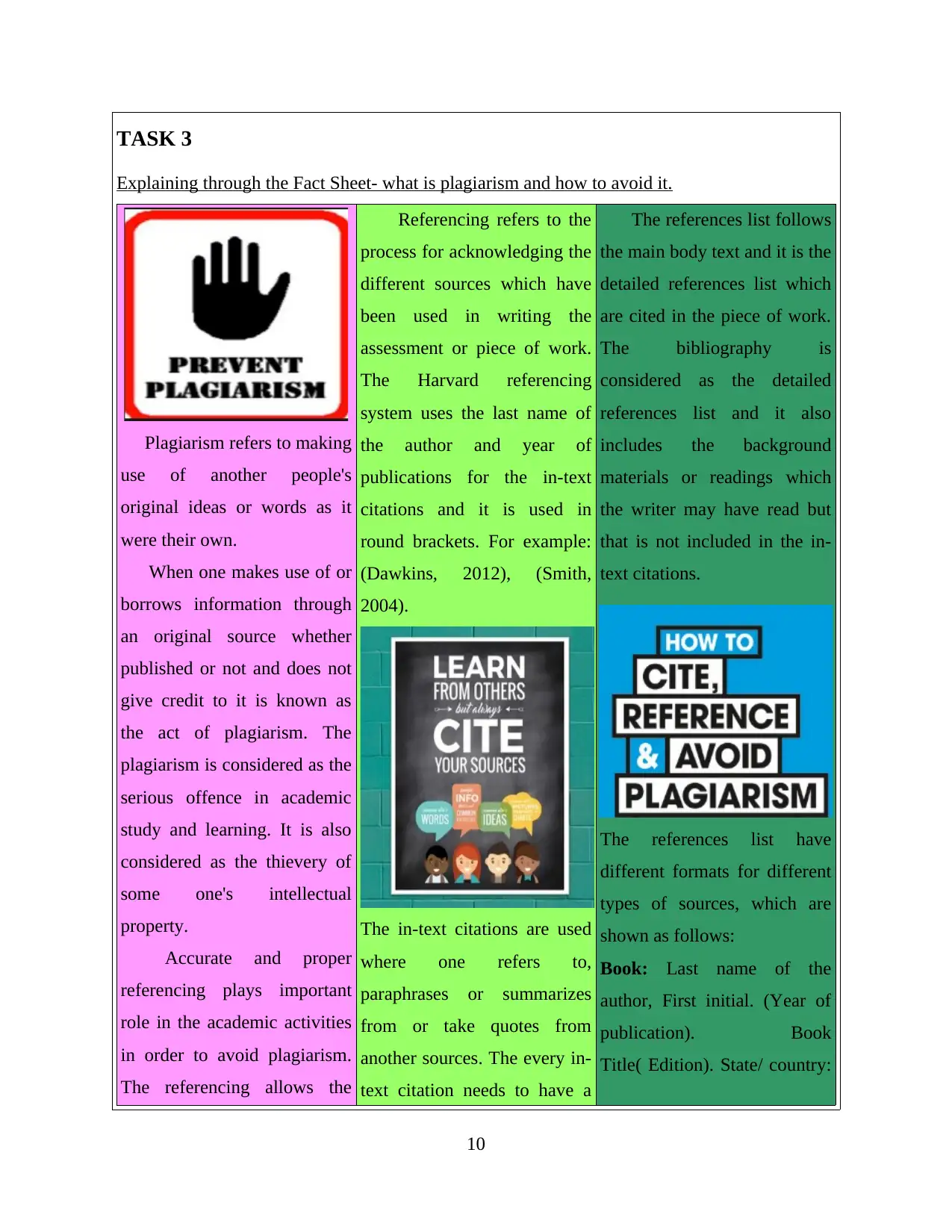
TASK 3
Explaining through the Fact Sheet- what is plagiarism and how to avoid it.
Plagiarism refers to making
use of another people's
original ideas or words as it
were their own.
When one makes use of or
borrows information through
an original source whether
published or not and does not
give credit to it is known as
the act of plagiarism. The
plagiarism is considered as the
serious offence in academic
study and learning. It is also
considered as the thievery of
some one's intellectual
property.
Accurate and proper
referencing plays important
role in the academic activities
in order to avoid plagiarism.
The referencing allows the
Referencing refers to the
process for acknowledging the
different sources which have
been used in writing the
assessment or piece of work.
The Harvard referencing
system uses the last name of
the author and year of
publications for the in-text
citations and it is used in
round brackets. For example:
(Dawkins, 2012), (Smith,
2004).
The in-text citations are used
where one refers to,
paraphrases or summarizes
from or take quotes from
another sources. The every in-
text citation needs to have a
The references list follows
the main body text and it is the
detailed references list which
are cited in the piece of work.
The bibliography is
considered as the detailed
references list and it also
includes the background
materials or readings which
the writer may have read but
that is not included in the in-
text citations.
The references list have
different formats for different
types of sources, which are
shown as follows:
Book: Last name of the
author, First initial. (Year of
publication). Book
Title( Edition). State/ country:
10
Explaining through the Fact Sheet- what is plagiarism and how to avoid it.
Plagiarism refers to making
use of another people's
original ideas or words as it
were their own.
When one makes use of or
borrows information through
an original source whether
published or not and does not
give credit to it is known as
the act of plagiarism. The
plagiarism is considered as the
serious offence in academic
study and learning. It is also
considered as the thievery of
some one's intellectual
property.
Accurate and proper
referencing plays important
role in the academic activities
in order to avoid plagiarism.
The referencing allows the
Referencing refers to the
process for acknowledging the
different sources which have
been used in writing the
assessment or piece of work.
The Harvard referencing
system uses the last name of
the author and year of
publications for the in-text
citations and it is used in
round brackets. For example:
(Dawkins, 2012), (Smith,
2004).
The in-text citations are used
where one refers to,
paraphrases or summarizes
from or take quotes from
another sources. The every in-
text citation needs to have a
The references list follows
the main body text and it is the
detailed references list which
are cited in the piece of work.
The bibliography is
considered as the detailed
references list and it also
includes the background
materials or readings which
the writer may have read but
that is not included in the in-
text citations.
The references list have
different formats for different
types of sources, which are
shown as follows:
Book: Last name of the
author, First initial. (Year of
publication). Book
Title( Edition). State/ country:
10
⊘ This is a preview!⊘
Do you want full access?
Subscribe today to unlock all pages.

Trusted by 1+ million students worldwide
1 out of 18
Related Documents
Your All-in-One AI-Powered Toolkit for Academic Success.
+13062052269
info@desklib.com
Available 24*7 on WhatsApp / Email
![[object Object]](/_next/static/media/star-bottom.7253800d.svg)
Unlock your academic potential
Copyright © 2020–2025 A2Z Services. All Rights Reserved. Developed and managed by ZUCOL.




